BMW 325i Wagon 2002, 330i Wagon 2002 Owner's Manual

Owner's Manual for Vehicle

325i
325xi
Congratulations, and thank you for choosing a BMW.
Thorough familiarity with your vehicle will provide you with enhanced control and security when you drive it. Therefore we have one request:
Please take the time to read this Owner's Manual and familiarize yourself with the information that we have compiled for you before starting off in your new BMW. The manual contains important data and instructions intended to assist you in obtaining maximum satisfaction from your BMW's unique array of advanced technical features. It also contains information on vehicle maintenance designed to enhance operating safety while simultaneously helping you to maintain your BMW's value throughout an extended service life. For additional information refer to the supplemental manuals.
This Owner's Manual should be considered a permanent part of this vehicle. It should stay with the vehicle when sold to provide the next owner with important operating, safety and maintenance information.
This manual is supplemented by a Service and Warranty Information Booklet (US models) or a Warranty and Service Guide Booklet (Canadian models). We recommend that you read this publication thoroughly.
Your BMW is covered by the following warranties:
–New Vehicle Limited Warranty
–Limited Rust Perforation Warranty
–Federal Emissions System Defect Warranty
–Federal Emissions Performance Warranty
–California Emission Control System Limited Warranty
Detailed descriptions of these warranties are provided in the Service and Warranty Information Booklet (US models) or in the Warranty and Service Guide Booklet (Canadian models).
We wish you an enjoyable driving experience.
BMW AG
Contents
Overview |
Cockpit 14 |
|
featuresand |
Instrument cluster 15 |
|
||
|
|
|
|
|
Indicator and warning lamps 17 |
|
|
|
Multifunction steering wheel |
|
|
|
(MFL) 21 |
|
|
|
Hazard warning triangle |
22 |
|
|
Refueling 22 |
|
Controls |
|
Fuel specifications 23 |
|
|
|
|
|
|
|
Tire inflation pressures |
24 |
|
© 2001 Bayerische Motoren Werke Aktiengesellschaft
Munich, Germany
Reprinting, including excerpts, only with the written consent of BMW AG, Munich. Order No. 01 41 0 156 156
US English VIII/01
Printed in Germany
Printed on environmentally friendly paper (bleached without chlorine, suitable for recycling).
Opening and closing:
Keys 28
Central locking system 28 Opening and closing – via the
remote control 29 Opening and closing – via the
door lock 31
Opening and closing – from the inside 32
Tailgate 33 Rear window 34 Cargo area 35 Alarm system 35
Electric power windows 37 Sliding/tilt sunroof 38
Adjustments:
Correct sitting posture 40 Seats 40
Manual seat adjustment 41 Power seat adjustment 42 Lumbar support 42
Head restraints 43 Safety belts 44
Seat and mirror memory 45 Seat heating 46
Steering wheel 46 Mirrors 47
Passenger safety systems:
Airbags 48
Transporting children safely 51
Vehicle Memory, Key
Memory 54
Driving:
Ignition lock 55 Starting the engine 55
Switching off the engine 56 Parking brake 57
Manual transmission 57 Automatic transmission with
Steptronic 58 Indicator/Headlamp flasher 60 Washer/Wiper system/Rain
sensor 61 Cruise control 63
Everything under control:
Odometer 65
Tachometer 65 Energy control 65 Fuel gauge 66
Coolant temperature gauge 66 Service Interval Display 66 Check Control 67
Clock 67 Computer 68
Technology for safety and driving convenience:
Park Distance Control (PDC) 70 Automatic Stability Control plus
Traction (ASC+T) 71
Dynamic Stability Control (DSC) 73

Controls and features
Hill Descent Control (HDC) |
77 |
Tire Pressure Monitor (RDC) |
78 |
Flat Tire Monitor 80 |
|
Lamps:
Parking lamps/Low beams 82 Instrument lighting 83
High beams/Standing lamps 83 Fog lamps 83
Interior lamps 84
Controlling the climate for pleasant driving:
Air conditioning 85 Automatic climate control 88
Interior conveniences:
Sound system 91 Glove compartment 92
Storage compartments 92 Cellular phone 94 Ashtray, front 94
Ashtray, rear 95
Electrical power socket 95
Loading and transporting:
Ski bag 96 Cargo area 97 Cargo loading 99
Roof-mounted luggage rack 100
Operation, maintenance
Special operating instructions: |
In the engine compartment: |
||
Break-in procedure 104 |
Hood 112 |
||
Driving notes 105 |
Engine compartment |
||
Antilock Brake System |
essentials 113 |
||
(ABS) 105 |
|
Washer fluids 114 |
|
Brake system 106 |
Engine oil 115 |
||
Wheels and tires: |
Coolant 117 |
||
Brake fluid 118 |
|||
Tire inflation pressure 107 |
|||
|
|||
Tire condition 107 |
Maintenance: |
||
Tire replacement |
108 |
The BMW Maintenance |
|
Wheel and tire |
|
System 119 |
|
combinations |
110 |
|
|
Winter tires 111 |
Laws and regulations: |
|
Technical modifications 120 |
||
|
||
|
California Proposition |
|
|
65 Warning 120 |
|
|
OBD interface socket 121 |
5
Repairs Maintenance Controls Overview
Index Data
Contents
procedures |
Replacement procedures: |
||
Onboard tool kit 124 |
|||
|
|||
|
Windshield wiper blades 124 |
||
|
Lamps and bulbs |
125 |
|
|
Changing a wheel |
129 |
|
service |
Battery 133 |
|
|
receiving: |
|
||
|
Fuses 133 |
|
|
Owner |
Assistance, giving and |
||
Jump-starting 134 |
|||
|
|||
|
Towing the vehicle |
135 |
|
Technical data
Engine data 140 Dimensions 141 Weights 142 Capacities 143
Index
Everything from A to Z 146

8
Notes on the Owner's Manual
We have made every effort to ensure that you are able to find what you need in this Owner's Manual as quickly as possible. The fastest way to find specific topics is by using the detailed index at the end. If you wish to gain only an initial overview of your vehicle, you will find this in the first chapter. The detailed table of contents is intended to stimulate your interest and encourage you to read the remainder of the manual.
Should you wish to sell your BMW at some time in the future, please remember to hand over this Owner's Manual to the new owner; it is legal part of the vehicle.
If you have any additional questions, your BMW center will be glad to advise you.
Symbols used
Indicates precautions that must be followed precisely in order to avoid the possibility of personal injury and serious damage to the vehicle.<
Contains information that will assist you in gaining the optimum
benefit from your vehicle and enable you to care more effectively for your vehicle.<
Refers to measures that can be taken to help protect the
environment.<
< Marks the end of a specific item of information.
* Indicates special equipment, countryspecific equipment and optional extras.
Identifies systems or components, which can either be activated or
adapted to suit an individual driver's requirements ("Vehicle Memory", "Key Memory"), refer to page 54. Remember that activation and adjustments on some of these systems can only be performed at your BMW center.<
Your individual vehicle
On purchasing your BMW, you have decided in favor of a model with individualized equipment and features. This Owner's Manual describes all models and equipment that BMW offers within the same group.
We hope you will understand that equipment and features are included that you might not have chosen for your vehicle. You can easily identify any differences with the aid of the asterisk * used to identify all optional equipment and accessories.
If your BMW features equipment which is not described in this Owner's Manual (car radio or telephone, for instance), supplementary Owner's Manuals are enclosed. We ask you to read these manuals as well.

Status at time of printing
BMW pursues a policy of continuous, ongoing development designed to ensure that our vehicles continue to embody the highest quality and safety standards combined with advanced, state-of-the-art technology. For this reason, it is possible that the features described in this Owner's Manual could differ from those on your vehicle. Nor can errors and omissions be entirely ruled out. You are therefore asked to appreciate that no legal claims can be recognized on the basis of the data, illustrations or descriptions in this Owner's Manual.
9n
Repairs Maintenance Controls Overview
Index Data

10
For your own safety
Use unleaded gasoline only. Fuels containing up to and including
10% ethanol or other oxygenates with up to 2.8% oxygen by weight (i.e. 15% MTBE or 3 % methanol plus an equivalent amount of co-solvent) will not void the applicable warranties
respecting defects in materials or workmanship. Field experience has indicated significant differences in fuel quality (volatility, composition, additives, for example) among gasolines offered for sale in the United States and Canada. The use of poor-quality fuels may result in driveability, starting and stalling problems especially under certain environmental conditions, such as high ambient temperature and high altitude.
Should you encounter driveability problems which you suspect could be related to the fuel you are using, we recommend that you respond by switching to a recognized high-quality brand.
Failure to comply with these recommendations may result in unscheduled maintenance.
Obey all applicable safety rules when you are handling gasoline.<
Important safety information!
For your own safety, use genuine parts and accessories approved by BMW.
When you purchase accessories tested and approved by BMW and Original BMW Parts, you simultaneously acquire the assurance that they have been thoroughly tested by BMW to ensure optimum performance when installed on your vehicle.
BMW warrants these parts to be free from defects in material and workmanship.
BMW will not accept any liability for damage resulting from installation of parts and accessories not approved by BMW.
BMW cannot test every product made by other manufacturers to ascertain whether it can be used on a BMW safely and without risk to either the vehicle, its operation, or its occupants.
Original BMW Parts, BMW Accessories and other products approved by BMW, together with professional advice on using these items, are available from all BMW centers.
Installation and operation of non-BMW approved accessories such as alarms,
radios, amplifiers, radar detectors, wheels, suspension components, brake dust shields, telephones (including operation of any portable cellular phone from within the vehicle without using an externally mounted antenna) or transceiver equipment (such as CB, walkietalkie, ham radio or similar) may cause extensive damage to the vehicle, compromise its safety, interfere with the vehicle's electrical system or affect the validity of the BMW Limited Warranty. Contact your BMW center for additional information.
Do not use key or remote control to lock doors or cargo area with anyone inside the vehicle. Refer to pages 29 and 32 for more details.<
Maintenance, replacement, or repair of the emission control
devices and systems may be performed by any automotive repair establishment or individual using any certified automotive part.<
Symbol on vehicle parts
Indicates that you should consult the relevant section of this
Owner's Manual for information on a particular part or assembly.
Online Edition for Part No. 01 41 0 156 156 - © 09/01 BMW AG

The following applies only to vehicles owned and operated in the US.
REPORTING SAFETY DEFECTS
If you believe that your vehicle has a defect which could cause a crash or could cause injury or death, you should immediately inform the National Highway Traffic Safety Administration (NHTSA) in addition to notifying BMW of North America, LLC, P.O. Box 1227, Westwood, New Jersey 07675-1227, Telephone (201) 307-4000.
If NHTSA receives similar complaints, it may open an investigation, and if it finds that a safety defect exists in a group of vehicles, it may order a recall and remedy campaign. However, NHTSA cannot become involved in individual problems between you, your dealer, or BMW of North America, LLC.
To contact NHTSA, you may either call the Auto Safety Hotline toll-free at 1-800-424-9393 (or 366-0123 in Washington, D.C. area) or write to: NHTSA, U.S. Department of Transportation, Washington, D.C. 20590. You can also obtain other information about motor vehicle safety from the Hotline.
11n
Repairs Maintenance Controls Overview
Index Data
Online Edition for Part No. 01 41 0 156 156 - © 09/01 BMW AG

12

13
Overview
Controls in detail
Operation, maintenance
Owner service procedures
Technical data
Index
Repairs Maintenance Controls Overview
Data
Index
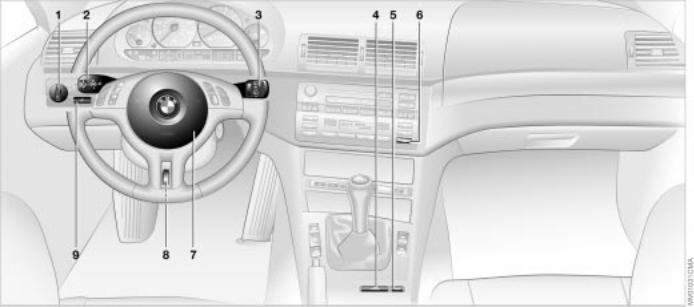
14 Cockpit
1Parking lamps/Low beams 82
2> Turn signal indicators 60
>Standing lamps 83
>High beams 83
>Headlamp flasher 60
>Computer 68
3 |
Washer/Wiper system/Rain |
6 Rear window defroster 86, 90 |
|
|
sensor 61 |
7 |
Horn: the entire surface |
|
|
||
4 |
Hazard warning flashers |
8 |
Adjusting the steering wheel 46 |
|
|
||
5 |
Central locking system 28 |
9 |
Fog lamps 83 |
|
|
||

Instrument cluster
1 |
Fuel gauge 66 |
3 |
Speedometer |
2 |
Indicator lamps for turn signals 20 |
4 |
Indicator and warning |
|
|
|
lamps 17 to 20 |
15 |
|
|
|
|
|
|
Overview |
|
|
|
|
|
Controls |
|
|
|
|
|
Maintenance |
|
|
|
|
|
Repairs |
|
5 Tachometer and Energy control 65 |
|
|
|
||
6 Engine coolant temperature |
Data |
|
gauge 66 |
||
|
||
|
|
|
|
|
|
|
Index |
|
|
|

16 Instrument cluster
7 |
Indicator and warning |
|
10 Display for |
|
|
lamps 17 to 20 |
|
> Trip odometer/Odometer 65 |
|
8 |
Reset trip odometer to zero |
65 |
> Clock 67 |
|
> Service Interval 66 |
||||
9 |
Indicator for Check Control |
67 |
||
> Computer 68 |
||||
|
|
|
11Selector lever and program display for automatic transmission 18, 60
12Clock reset button 67
13Indicator and warning lamps 17 to 20

Indicator and warning lamps
Technology that monitors itself
Indicator and warning lamps that are identified by ● are tested for proper functioning whenever the ignition key is turned. They each light up once for different periods of time.
If a fault should occur in one of these systems, the corresponding lamp does not go out after the engine is started, or it lights up while the vehicle is moving. You will see how to react to this in the following section.
Red: stop immediately
Battery charge current ●
The battery is no longer being charged. Indicates a defective alternator drive belt or a problem with the alternator's charge circuit. Please
contact the nearest BMW center.
If the drive belt is defective, stop and switch off the engine immedi-
ately to prevent overheating and serious engine damage. If the drive belt is defective, increased steering effort is also required.<
Engine oil pressure ●
Stop the vehicle immediately and switch off the engine.
Check the engine oil level and top off as required. If the oil level is correct, please contact the nearest BMW center.
Do not continue driving, as the engine could sustain serious
damage from inadequate lubrication.<
17
Brake warning lamp ●
If the lamp comes on when the parking brake is not engaged:
check the brake fluid level. Before driving further, be sure to comply with the instructions on pages 106 and 118
Brake warning lamp for Canadian models.
Tire Pressure Monitor (RDC)/ Flat Tire Monitor ●
In addition, an acoustic signal is sounded: a tire failure has occurred. Reduce vehicle speed immediately and stop the vehicle. Avoid hard brake applications. As you steer the vehicle, use caution and avoid overcorrecting. For additional information refer to pages 78, 80
Repairs Maintenance Controls Overview
Index Data

18 Indicator and warning lamps
Red and yellow: continue driving cautiously
The brake warning lamp comes on together with the yellow indicator lamps for ABS and ASC+T/DSC:
The entire ABS, CBC, ASC+T/ DSC and ADB/ADB-X/DBC control system has failed. Continue driving cautiously and
defensively. Avoid full brake applications. Please have the system checked by your BMW center as soon as possible.
For additional information refer to pages 71, 73
CBC, ABS and ASC+T/DSC and ADB/ADB-X/DBC indicator and warning lamps for Canadian models.
Red: an important reminder
Parking brake warning lamp Comes on when the parking brake is engaged – an additional
acoustic signal sounds when starting off.
For additional information refer to page 57
Parking brake warning lamp for Canadian models.
Fasten safety belts ●
An acoustic warning also sounds in some versions. Lights
up either for several seconds or until the belt is engaged, depending upon version.
For additional information on safety belts refer to page 44
Airbags ●
Please have the system inspected by your BMW center.
For additional information refer to page 48
Orange: consult the nearest BMW center
Automatic transmission The transmission has
responded to a malfunction by reverting to operation in its emergency default program. Please consult the nearest BMW center.
For additional information refer to page 58
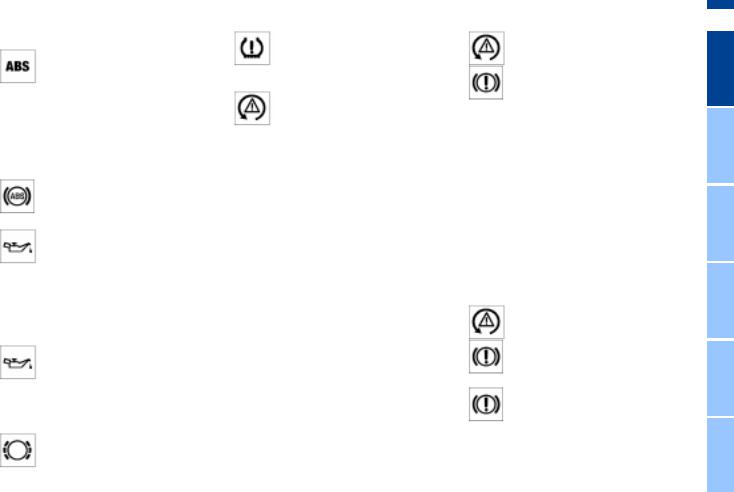
Indicator and warning lamps
Yellow: check as soon as possible
Antilock Brake System (ABS) ● ABS has been deactivated in response to system malfunction.
Conventional braking performance remains available with no loss of efficiency. Please have the system inspected by your BMW center.
For additional information refer to page 105
ABS warning lamp for Canadian models.
Engine oil level
Comes on while driving: the engine oil level has fallen to the
absolute minimum; refill as soon as possible. Do not drive more than approx. 30 miles (50 km) until you do. For additional information refer to page 115
Engine oil level
Comes on after the engine has been switched off: add engine oil at the earliest opportunity (next time
you stop to refuel). For additional information refer to page 115
Brake pads ●
Have the brake pads checked. For additional information refer
to page 106
Tire Pressure Monitor (RDC)/Flat Tire Monitor ●
Check tire inflation pressures, refer to pages 24, 78, 80
Automatic Stability Control plus Traction (ASC+T)/Dynamic Stability Control (DSC) ●
Indicator lamp flashes:
The system is actively regulating drive torque and braking force.
The indicator lamp stays lit:
ASC+T has been switched off with the button or it is defective or, the DSC has been switched off, ADB is operational. Please contact the nearest BMW center in case of a malfunction.
For additional details refer to information beginning on page 71
BMW 325xi:
DSC has been switched off manually or there is a system malfunction. ADB-X is operational in its standby mode. If the warning lamp fails to go out when you press the DSC button again, this indicates a system malfunction affecting both DSC and ADB-X.
Please consult the nearest BMW center.
For additional information refer to page 75
19
Indicator lamp for Automatic Stability Control plus Traction (ASC+T)/Dynamic Stability Control (DSC) and brake warning lamp ●
The indicator lamps remain on: The DSC and ADB/DBC have been switched off with the button or are defective.
Please consult the nearest BMW center. For additional information refer to page 73
BMW 325xi:
DSC and ADB-X system malfunction. There is no provision for switching off ADB-X.
Please consult the nearest BMW center. For additional information refer to page 75
DSC and ADB indicator and warning lamps for Canadian models.
Dynamic Brake Control (DBC) ● Malfunction in DBC system. Conventional braking efficiency
is available and unrestricted.
Have the system repaired at your BMW center as soon as possible. For additional information refer to page 74
Repairs Maintenance Controls Overview
Index Data

20 Indicator and warning lamps
Add washer fluid
The washer fluid level is too low. Top off the fluid at the earliest
opportunity. For additional information refer to page 114
SERVICE ENGINE SOON ●
If the indicator lamp comes on either continuously or intermittently, this indicates a fault in the emis-
sions-related electronic systems. Although the vehicle remains operational, you should have the systems checked by your BMW center at the earliest possible opportunity.
For additional information refer to page 121.
SERVICE ENGINE SOON warning lamp for Canadian models.
Engine electronics ●
There is a fault in the electronic engine-management system.
You can continue to drive with reduced engine output or engine speed. Please have the system inspected at your BMW center.
Add coolant
The coolant level is too low. Add coolant at the earliest opportunity. For additional information refer to
page 117
Green: for your information
Turn signal indicator
Flashes when the turn signals are on.
Rapid flashing indicates a system malfunction.
For additional information refer to page 60
Cruise control
Lights up when the cruise control is activated: available for
operation via the multifunction steering wheel.
For additional information refer to page 63
Fog lamps
Lights up whenever you switch on the fog lamps.
For additional information refer to page 83
Blue: for your information
High beams
Comes on when the high beams are on or the headlamp flasher
is actuated.
For additional information refer to pages 60, 83

Multifunction steering wheel (MFL)*
The buttons integrated in the multifunction steering wheel are provided so that you can operate a number of accessories quickly and without being distracted from traffic conditions. You may operate:
>Selected radio functions
>The cruise control
>Selected cellular phone functions.
The controls are active only when the corresponding systems and
accessories are switched on.<
Press briefly:
Receive a phone call, initiate dialing, terminate a call.
Switch between phone, radio, cassette and CD.
Forward:
>Radio
Press briefly: station scan in FM band Extended pressure: search function
>CD
Press briefly: jump to next track Extended pressure: search function in track
>Cassette
Press briefly: stop track scan or fast forward
Extended pressure: fast forward
>Phone
Scan personal phone book.
Rewind/reverse: functions as fast forward.
21
Volume
Cruise control: select a stored setting.
Cruise control: store and accelerate (+) or decelerate and store (–).
Cruise control: activate/interrupt/deactivate.
Repairs Maintenance Controls Overview
Index Data

22 Hazard warning triangle* Refueling
Always observe all safety precautions posted at the service station
when handling fuel. Never carry spare fuel containers in your vehicle. Whether empty or full, these containers can leak, cause an explosion, or lead to fire in the event of a collision.<
The warning triangle is located on the left side of the cargo area behind the cover panel.
To open: press the button (arrow) and remove the cover.
Always observe all legal regulations requiring a warning triangle
to be carried in the vehicle.<
Fuel filler door
Before filling the tank, switch off the engine. If you do not, fuel
cannot be filled into the tank and the SERVICE ENGINE SOON lamp may come on.<
Press on the rear edge of the fuel filler door to open and close it.
Manual release: undo the trim panel on the right side of the cargo area. Pull the knob with the fuel pump symbol.
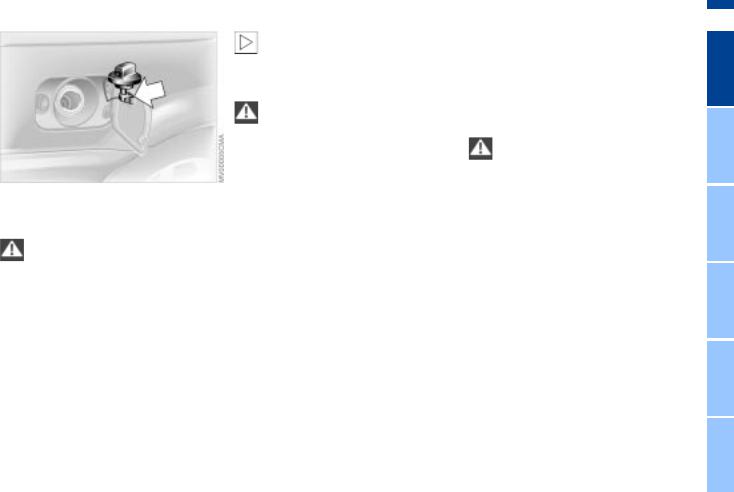
Refuel
Simple and environmentally friendly
Open the fuel filler cap carefully to prevent fuel from spraying out.
Fuel spray may cause injury.<
Put the filler cap in the bracket (arrow) attached to the fuel filler door.
When refueling, insert the filler nozzle completely into the filler pipe. Pulling the nozzle out of the pipe during refueling
>results in premature pump shutoff
>and will reduce the effectiveness of the vapor recovery system on the pump.
As long as the filler nozzle is used properly, the fuel tank is full whenever the nozzle shuts off the first time.
Refill early to avoid damaging the catalytic converter; never attempt
to drive to the last drop of fuel in the tank.<
Close the fuel filler cap carefully after refueling until a click is
heard. While closing, be sure not to squeeze the strap which is fastened to the cap. A loose or missing cap will activate the CHECK FILLER CAP lamp or the SERVICE ENGINE SOON lamp.<
Tank capacity: approx. 16.6 gal. (63 liters), incl. a reserve capacity of approx. 2.1 gal. (8 liters).
Fuel specifications |
23 |
The engine uses lead-free gasoline only.
Required fuel:
>Premium Unleaded Gasoline, min. 91 AKI.
AKI = Anti Knock Index
Never use leaded fuel, as it would cause permanent and irreversible
damage to the oxygen sensor and the catalytic converter.<
Repairs Maintenance Controls Overview
Index Data
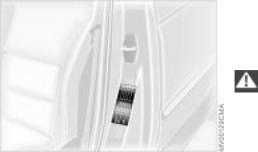
24 Tire inflation pressures
The specified inflation pressures are provided on a sticker attached to the B-pillar and visible with the driver's door open.
Checking tire pressures
All pressures are specified in the standard units of pressure for your country, psi or kilopascal, and apply to cold tires (tires at ambient temperature, refer to tire pressure table on the following page).
Vehicles with Tire Pressure Monitor (RDC)/Flat Tire Monitor:
After correcting the inflation pressures, reactivate the system, refer to
pages 78, 80.
Another instruction plate regarding inflation pressures on the door pillar indicates which system is equipped on your vehicle.
Check the tire pressures on a regular basis – at least twice a month – and before every extended
journey. Otherwise, incorrect tire pressure can lead to driving instability, tire damage and accidents.
Remember to check the inflation pressure in the space-saver or standard spare tire.
Inflate the spare tire to the highest inflation pressure of any tire on your vehicle.<
Comply with tire approval specifications
The inflation pressures in the table apply to BMW approved tire sizes and tire manufacturers. Your BMW center is familiar with these pressures. Higher pressures may be specified for tires made by other manufacturers.
Your vehicle is equipped with tires that not only meet US standards, but also European standards. We recommend the exclusive use of BMW approved tires.
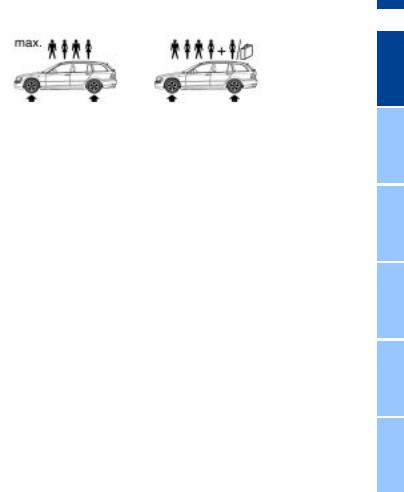
Tire inflation pressures
BMW |
Tires |
|
|
|
|
|
|
All pressure specifications in the table are |
|
|
|
|
|
|
indicated in psi (kilopascal) with cold tires |
|
|
|
|
|
|
(cold = ambient temperature) |
|
|
|
|
|
|
|
|
|
|
|
|
|
205/55 R 16 91 H M+S |
|
|
|
|
|
|
205/55 R 16 91 H |
32 (220) |
38 (260) |
38 (260) |
45 (310) |
|
|
225/50 R 16 92 W (not 325xi) |
|
||||
|
|
|
|
|
|
|
|
225/45 R 17 91 W |
|
|
|
|
|
|
|
|
|
|
|
|
|
225/45 ZR 17 |
32 (220) |
– |
38 (260) |
– |
|
325i |
245/40 ZR 17 |
– |
38 (260) |
– |
45 (310) |
|
|
|
|
|
|
|
|
205/50 R 17 93 V M+S extra load |
|
|
|
|
|
|
325xi |
|
|
|
|
|
|
205/50 R 17 93 W extra load |
|
|
|
|
|
|
|
|
|
|
|
|
|
|
205/55 R 16 91 Q M+S |
35 (240) |
41 (280) |
41 (280) |
48 (330) |
|
|
225/50 R 16 92 Q M+S (not 325xi) |
|
||||
|
|
|
|
|
|
|
|
205/50 R 17 93 Q M+S extra load |
|
|
|
|
|
|
225/45 R 17 91 Q M+S |
|
|
|
|
|
|
|
|
|
|
|
|
|
Space-saver spare tire in cargo area |
|
61 (420) |
|
|
|
|
|
|
|
|
|
|
25
Repairs Maintenance Controls Overview
Index Data

26
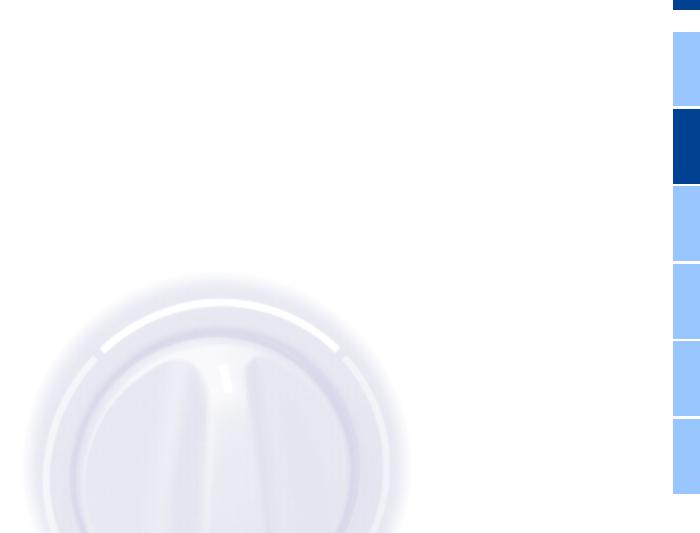
27
Overview
Controls in detail
Operation, maintenance
Owner service procedures
Technical data
Index
Repairs Maintenance Controls Overview
Index Data
Online Edition for Part No. 01 41 0 156 156 - © 09/01 BMW AG

28 Keys |
Central locking system |
2 Spare key for storage in a safe place, such as in your wallet. This key is not intended for constant use
3 Door and ignition key
The lock for the glove compartment cannot be operated with this key – this is useful for valet parking, for instance.
The key set
1Master keys with remote control unit, determine the functions of the Key Memory, refer to page 54.
You can mark individual keys for subsequent identification by applying the colored decals that you received when accepting delivery of your vehicle.
Each master key is equipped with an extended-life battery. This
battery is recharged in the ignition lock during normal operation.
For this reason, if you have master keys that are not being used you should use those keys approx. once a year while driving for an extended period to charge the battery, refer also to
page 29.<
The concept
The central locking system is ready for operation whenever the driver's door is closed. The system engages and releases the locks on the
>doors
>tailgate and rear window
>fuel filler door.
The central locking system can be operated
>from outside via the remote control as well as via the driver's door lock
>from inside by pressing a button.
Operating it from inside does not lock the fuel filler door, refer to page 32. When the system is operated from the outside, the anti-theft system is activated simultaneously. Both the door locks and release handles remain locked. The alarm system is also armed or disarmed.
If locked from the inside, the central locking systems unlocks automatically in the event of an accident, but only doors which were not locked separately with the door lock buttons, refer to page 32. In addition, the hazard warning flashers and interior lamps come on.
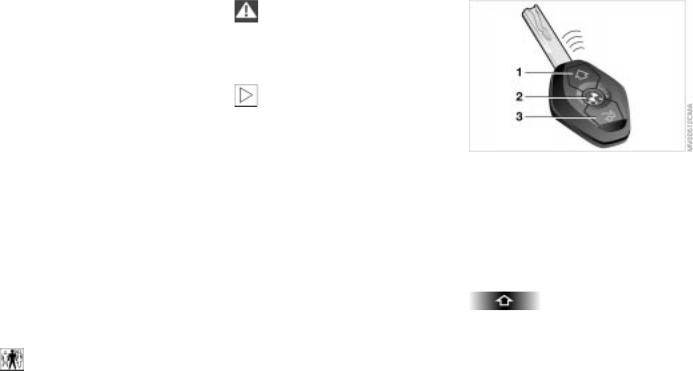
Opening and closing – via the remote control
The concept
The remote control gives you an exceptionally convenient method for unlocking and locking your vehicle. Furthermore, it provides two additional functions which you can only execute via the remote control:
>To switch on interior lamps, refer to page 30.
With this function, you can also search for the vehicle, when parked in an underground garage, for instance
>Opening the rear window, refer to page 30.
The rear window will open slightly, regardless of whether it was previously locked or unlocked.
Whenever you unlock (lock) the vehicle, you simultaneously deactivate (activate) the anti-theft system, disarm (arm) the alarm system and switch the interior lamps on (off).
You can have a signal set to confirm that the vehicle's locks
have engaged securely.<
Since children might be able to lock the doors from the inside, always take the vehicle keys with you
so that the vehicle can be opened again from the outside at any time.<
If it is no longer possible to lock the vehicle via the remote control,
the battery is discharged. Use this key while driving for an extended period in order to recharge the battery.
To prevent unauthorized use of the remote control, surrender only the door and ignition key or the spare key when leaving the vehicle for valet parking, for example, refer to page 28.
In the event of a system malfunction, please contact your BMW center. You can also obtain replacement keys there.<
|
29 |
|
|
|
|
|
|
Overview |
|
|
|
|
|
Controls |
|
|
|
lamps, deactivate tilt alarm sensor |
|
Maintenance |
1 Unlock and convenience opening |
|
|
mode |
|
|
2 Lock and secure, switch on interior |
|
|
and interior motion sensor |
|
|
|
|
|
|
|
|
3 Open rear window |
|
Repairs |
To unlock |
|
|
|
|
|
Press the button once to unlock the |
|
|
|
|
|
|
|
|
driver's door. |
|
|
Press the button a second time to |
|
Data |
unlock all vehicle locks. |
|
|
|
|
|
|
|
|
|
|
|
|
|
Index |
|
|
|
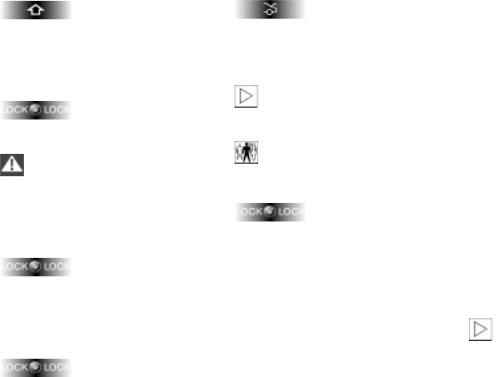
30 Opening and closing – via the remote control
Convenience opening mode |
To open the rear window |
Press and hold button: the power windows and sliding/tilt sunroof are opened.
To lock and secure
Press button.
Do not lock the vehicle if anyone will be remaining inside, as it
would then be impossible for the occupant(s) to disengage the locks from the inside.<
To switch on the interior lamps
After locking the vehicle, press button again.
Press button.
The rear window opens slightly. It can now be tilted up.
Before and after a trip, be sure that the rear window has not been
opened unintentionally.<
If you prefer, the tailgate will open instead of the rear window.<
Panic mode (trigger alarm)
By pressing the button for two to five seconds, the alarm system can be triggered in the event of danger, if it is armed.
Press the button to cancel the alarm.
To switch off tilt alarm sensor* and interior motion sensor*
Press button a second time immediately after locking. For additional information refer to page 36.
External systems
The remote control system's operation may be affected by other units or equipment operating in the immediate vicinity of your vehicle.
If this should occur, you can still open and close the vehicle using the master key in the door lock.
For US owners only
The transmitter and receiver units comply with part 15 of the FCC (Federal Communication Commission) regulations. Operation is governed by the following:
FCC ID: LX8EWS
LX8FZVS
LX8FZVE
Compliance statement:
This device complies with part 15 of the FCC Rules. Operation is subject to the following two conditions:
>This device may not cause harmful interference, and
>this device must accept any interference received, including interference that may cause undesired operation.
Any unauthorized modifications to these devices could void the
user's authority to operate the equipment.<
